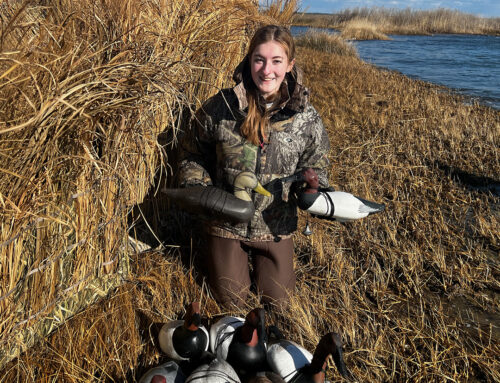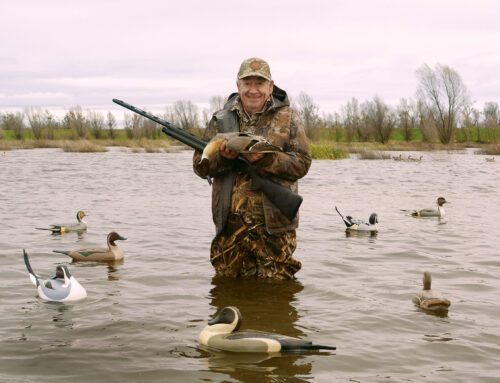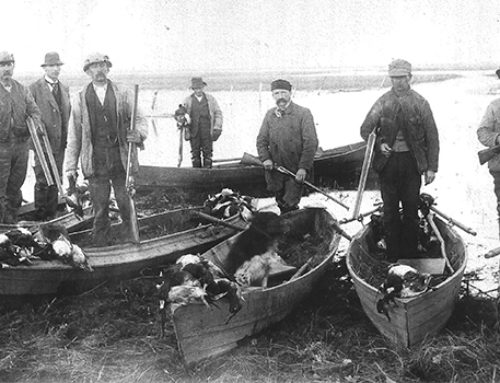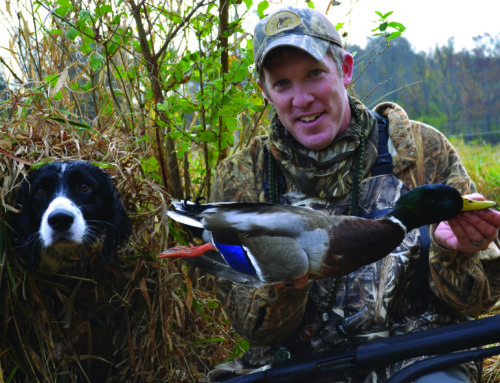Men Overboard

Many hunters call body booting ‘crazy,’ but these guys call it ‘fun!’
By Paul Wait
A rising tide of water rinsed over my shoulders as I gently kicked my feet to swim in a circle, all while eagerly eyeballing a flock of rapidly incoming mallards. Only my head and my hands were above the surface as I cowered behind a giant wooden silhouette painted to look like a Canada goose.
 An elongated box attached to the back of the goose held my essentials — a plastic bag of magnum steel shotshells and a bottle of water. Slots in each end of the box served as a cradle for my shotgun.
An elongated box attached to the back of the goose held my essentials — a plastic bag of magnum steel shotshells and a bottle of water. Slots in each end of the box served as a cradle for my shotgun.
I spun my “stickup,” which is what the hunters called the specialized goose silhouette mounted on a pivoting pole, with the flight of the ducks to keep my face hidden from them. Waves were literally lapping at my chin as the unsuspecting mallards closed to within shotgun range.
My gaze trained on a drake, I grabbed my shotgun from its holder as I straightened my knees enough to rise from the water and shoulder the stock. The startled mallard climbed straight skyward. I tried to track its fleeing path with my barrel, but I simply could not catch up.
The same tight-fitting survival wetsuit — a neoprene full-body covering made for diving in frigid water — that had afforded me stealth concealment, had now defied me by not allowing me to raise my arms high enough for what would have been a fairly easy overhead shot.
“I couldn’t get on that duck,” I decried to Matt Kneisley, who had managed to dump a mallard from the flock after he popped up from behind his own stickup 10 yards downline from mine.
“Yeah, it’s tough,” he said with a wry smile. “Welcome to body booting on the Susquehanna Flats.”
Evolution of Tactics
Kneisley, the Northeast regional events director for Delta Waterfowl, is a regular member of a special crew of duck hunters led by Capt. Joey Jobes, a master decoy maker from Havre de Grace, Maryland.
“Body booting is one of the deeply-rooted hunting traditions on Chesapeake Bay,” Kneisley said. “I love it.”
 So does Jobes. But the practice of using the wetsuits in the water to hide was born out of necessity.
So does Jobes. But the practice of using the wetsuits in the water to hide was born out of necessity.
“Back when sinkboxes were outlawed (1918), body booting is how people started hunting canvasbacks, our No. 1 duck back then on the Susquehanna Flats,” Jobes explained. “They got into old gas suits and chest waders and stood amongst their canvasback decoys.”
Massive rafts of canvasbacks were drawn to the Flats and Chesapeake Bay by thick mats of wild celery. Market gunners shot and sold canvasbacks by the railcar load for consumption in restaurants throughout the East. Body booting and bushwhacking replaced the tactic of hunting from sinkboxes for market gunners and sport hunters alike.
The thick celery started to die out in the 1950s, and was replaced by eelgrass, which attracts mallards and Canada geese. Body booting evolved to become a puddle duck and Canada goose hunt in the 1970s.
“If hunters hadn’t burned their canvasback decoys, they repainted them to be mallards and geese,” Jobes said.
Mobility is Key
The main benefit of body booting is mobility. Tidal fluctuations can render a stationary blind useless for several hours of daylight, while booting is possible through any tide in water from knee-deep to chest-high. You can also go wherever the ducks and geese are feeding or loafing.
“You’re not tied to one spot like a pit or a blind,” Jobes said. “You’re mobile, and can set up in different places to try to be there at the right time for the birds.”
Although body booting is similar to layout gunning in that the hunters hide in a big decoy spread serviced by a tender boat, booting has a distinct advantage.
“Body booting can be done with however many guys you want to put in those decoys and behind those stickups,” Jobes said.
But just like with layout gunning, the birds can often be fooled within feet of a hunter’s gun barrel.
“It’s a right-in-your-face type of hunting, especially when it gets cold,” Jobes said.
Thawing Out
Body booting isn’t for everyone. It’s extreme hunting, as I can attest after standing in 34-degree January water for nine hours. I was cold. Somewhere around lunchtime, I could no longer feel my toes.
But with Jobes’ crew, complaining earns a hunter the same ridicule as not helping put out decoys. When you step aboard his big boat, you’ve committed to hunt. In this game, that means you zip up your suit, dive over the side and tough it out.
Thankfully, my first day as a booter came on the heels of strong northerly winds and a fresh push of migrating ducks. I was fortunate — and nimble enough — to shoot a hybrid black duck/mallard drake, as well as a limit of mallards.
After we had hung our wetsuits to dry next to the big heater on Jobes’ boat, Kneisley asked me if I would ever go body booting again.
I think I nodded.
“I’ll need to warm up first.”
Editor/publisher Paul Wait enjoys trying new waterfowl hunting adventures.






Leave A Comment